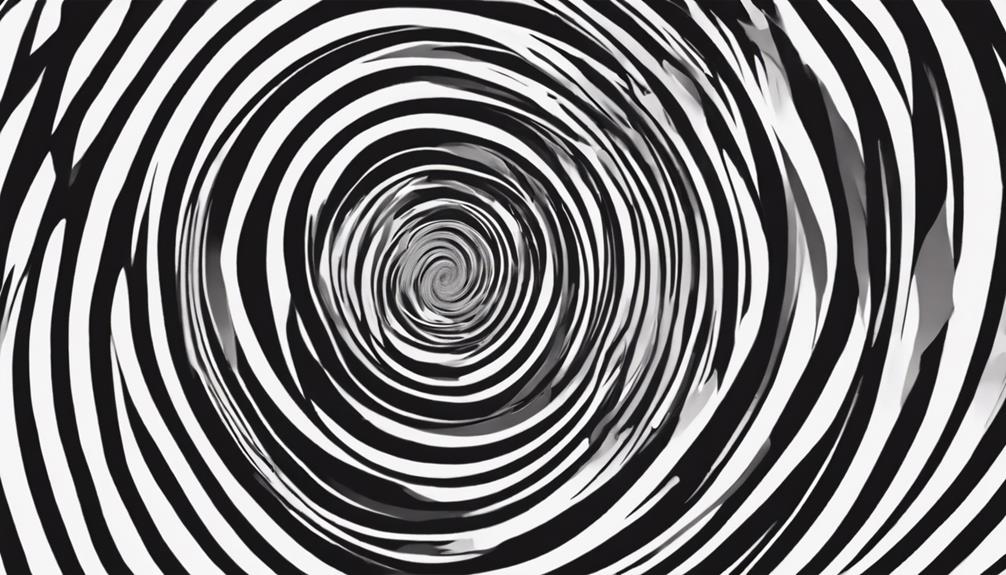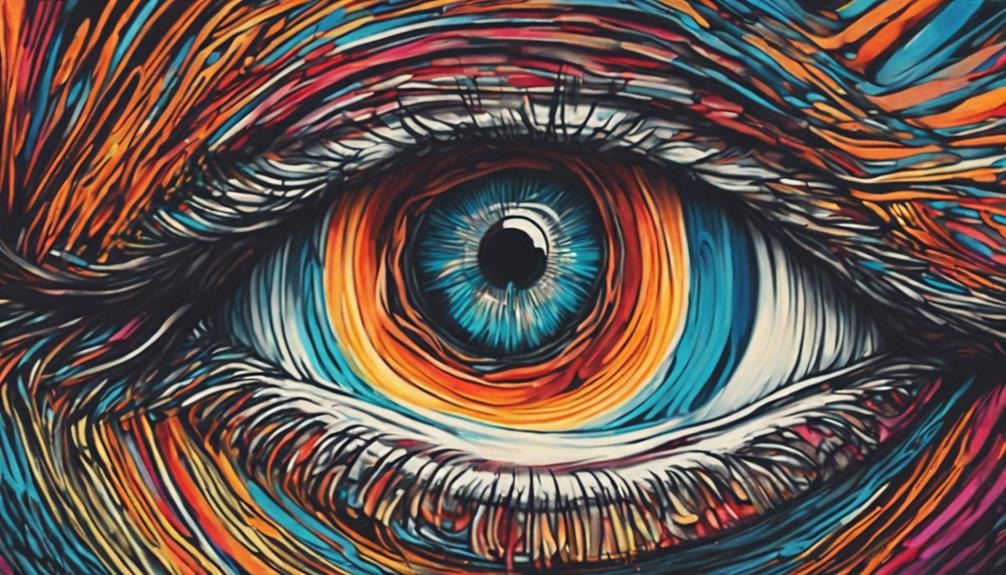Eye hypnosis, also referred to as ocular hypnosis, harnesses visual perception for inducing altered consciousness and psychological effects. Ancient civilizations like Egyptians and Greeks utilized eye hypnosis in spiritual rituals and medical practices. The science behind it involves manipulating visual perception through optical illusions to enhance suggestibility. Techniques for inducing eye hypnosis include hypnotic gaze, visual induction, and eye fixation. In modern psychology, it shows promise in treating conditions like chronic pain and anxiety disorders. Ethical considerations are vital for patient well-being in eye hypnosis practices. Further exploration includes integrating VR technology and AI algorithms for tailored experiences.
Ancient Origins of Eye Hypnosis

The practice of eye hypnosis can be traced back to ancient civilizations, where it was utilized for various spiritual and healing purposes. Historical practices reveal that cultures such as the ancient Egyptians, Greeks, and Persians used forms of eye hypnosis as a way to induce trance-like states for spiritual rituals, medical treatments, and even entertainment.
In these early societies, individuals believed that the eyes held a special power to connect with the subconscious mind and alter perceptions.
Cultural significance played a pivotal role in the development of eye hypnosis techniques. Shamans in indigenous tribes used eye-focused techniques to heal ailments and provide insights into the spiritual world. In ancient India, practitioners of yoga incorporated eye movements, known as drishti, to enhance concentration and meditation practices.
The cultural beliefs surrounding the eyes as windows to the soul and gateways to altered states of consciousness influenced the evolution of eye hypnosis throughout history. These early practices laid the foundation for the modern understanding and application of eye hypnosis techniques.
The Science Behind Eye Hypnosis
Understanding the phenomenon of eye hypnosis involves delving into the scientific principles that underpin its effects on the human mind and behavior. Optical illusions play a significant role in triggering eye hypnosis by manipulating visual perception. These illusions exploit how our brains process information from the eyes, leading to misinterpretations of reality.
By creating discrepancies between what our eyes see and how our brain interprets the visual stimuli, optical illusions can induce a state of heightened suggestibility and focus, key elements of eye hypnosis.
Visual perception, the process by which our brain interprets visual stimuli, is fundamental in understanding how eye hypnosis works. When exposed to specific visual patterns or stimuli that challenge our normal perception processes, our brains can be primed for suggestion and altered states of consciousness.
This alteration in perception can make individuals more receptive to external influences, making eye hypnosis techniques more effective in inducing desired behaviors or experiences. Through a deeper understanding of optical illusions and visual perception, the science behind eye hypnosis becomes clearer.
Techniques for Inducing Eye Hypnosis

Various techniques exist for inducing eye hypnosis, each leveraging specific methods to influence visual perception and suggestibility.
One common technique is the use of the hypnotic gaze, where the hypnotist maintains intense eye contact with the subject. This technique aims to establish a deep connection and focus the subject's attention solely on the hypnotist's eyes, enhancing receptivity to suggestions.
Visual induction is another effective method for inducing eye hypnosis. This technique involves using visual stimuli such as spinning objects or intricate patterns to captivate the subject's attention and induce a trance-like state. By fixating on these visual cues, the subject's mind becomes more open to receiving hypnotic suggestions.
Additionally, techniques like eye fixation, where the subject is instructed to stare at a single point, and eye closure, where the subject closes their eyes while visualizing specific images, can also be employed to induce eye hypnosis.
These techniques work by altering the subject's visual focus and encouraging a heightened state of suggestibility, making them valuable tools in the practice of eye hypnosis.
Applications in Modern Psychology
Applications of eye hypnosis in modern psychology extend beyond traditional hypnotic practices, exploring its potential in therapeutic interventions and cognitive research.
Regarding clinical benefits, eye hypnosis has shown promise in treating various conditions such as chronic pain, anxiety disorders, and even post-traumatic stress disorder. By utilizing eye fixation techniques, therapists can induce a state of focused attention in patients, facilitating relaxation and potentially reducing symptoms associated with these conditions.
Moreover, eye hypnosis has contributed to significant research advancements in the field of psychology. Researchers have used eye hypnosis to study attention mechanisms, memory processes, and even alterations in consciousness. Through techniques like eye movement desensitization and reprocessing (EMDR), scientists have gained insights into how eye movements can impact the processing of distressing memories and emotions.
This has opened up avenues for further exploration into the underlying mechanisms of psychological disorders and potential therapeutic interventions. Overall, the applications of eye hypnosis in modern psychology showcase its versatility and potential for both clinical practice and scientific inquiry.
Ethical Considerations in Eye Hypnosis

Ethical considerations surrounding the practice of eye hypnosis in psychology encompass a complex interplay of patient autonomy, practitioner responsibility, and potential risks. Patient consent is paramount in any therapeutic intervention, including eye hypnosis. Practitioners must make sure that clients fully understand the process, its implications, and any potential risks involved.
Respecting professional boundaries is essential to maintain the integrity of the therapeutic relationship and prevent any misuse of the hypnotic techniques.
Adherence to ethical guidelines is vital to safeguard the well-being of clients undergoing eye hypnosis. Practitioners should follow established ethical principles and standards set forth by relevant professional bodies to guarantee the highest level of care and integrity in their practice.
Additionally, practitioners must continually assess and mitigate potential risks associated with eye hypnosis, such as false memories or unintended psychological distress.
Ultimately, ethical considerations in eye hypnosis demand a vigilant commitment to patient welfare, informed consent, and adherence to professional standards to uphold the highest ethical standards in psychological practice.
Future Directions in Eye Hypnosis
Moving ahead, exploring innovative research avenues and advancements in technology holds promise for enhancing the efficacy and scope of eye hypnosis as a therapeutic modality.
Potential innovations in eye hypnosis could involve the integration of virtual reality (VR) technology to create immersive hypnotic experiences. By combining eye-tracking technology with VR, therapists could have real-time feedback on where the individual's focus lies during hypnosis, allowing for personalized interventions.
In addition, the use of artificial intelligence (AI) algorithms could analyze eye movement patterns to tailor hypnotic suggestions more effectively.
Emerging trends in eye hypnosis may also include the development of mobile applications or online platforms that offer remote eye hypnosis sessions. This could increase accessibility to hypnotherapy for individuals who are unable to attend in-person sessions.
Moreover, the incorporation of biofeedback devices into eye hypnosis practice could enable therapists to monitor physiological responses, such as heart rate variability, and adjust hypnotic techniques accordingly.
Conclusion
To sum up, the intricate interplay of gaze and focus in eye hypnosis holds the potential to access deep layers of the human mind. As we persist in uncovering the enigmas of this age-old practice through scientific investigation, we must also stay diligent in maintaining ethical standards.
The future of eye hypnosis offers the prospect of illuminating new paths for psychological healing and comprehension, shining a bright light on the unexplored realms of the human psyche.
Dr. John Renoldson is a distinguished professor of Clinical Research Hypnotherapy He holds a PhD in Clinical Psychology and specializes in hypnotherapy and scientific research to enhance therapeutic outcomes. Dr. Renoldson has authored numerous peer-reviewed articles on the efficacy of hypnosis in treating conditions.




